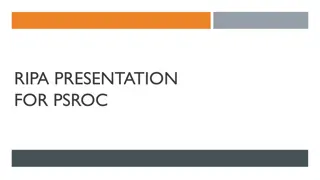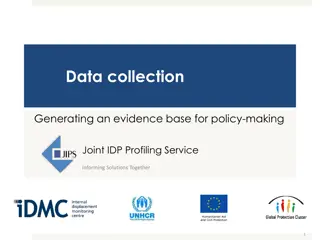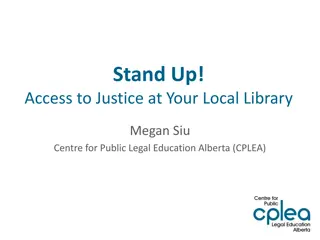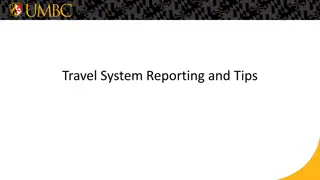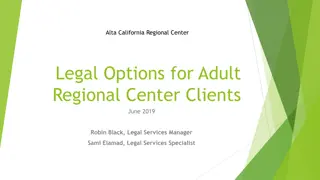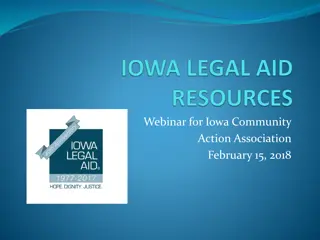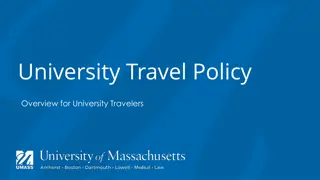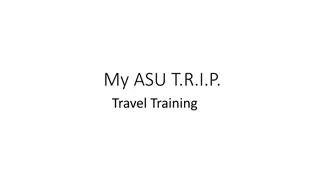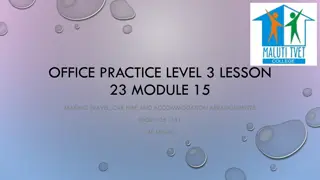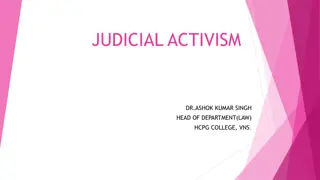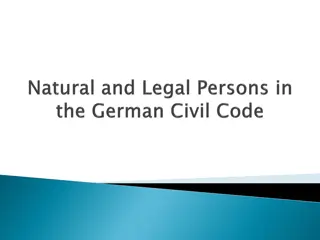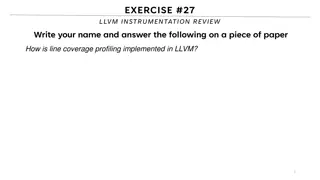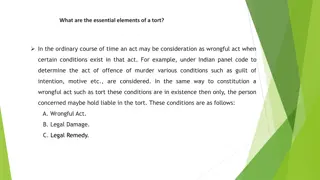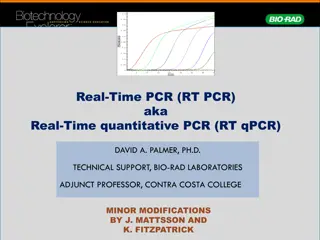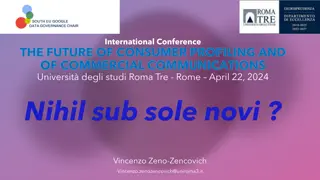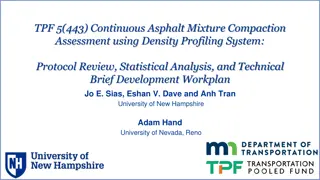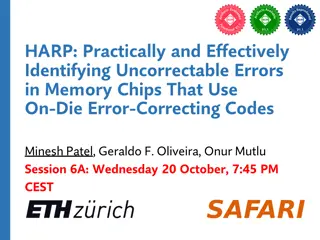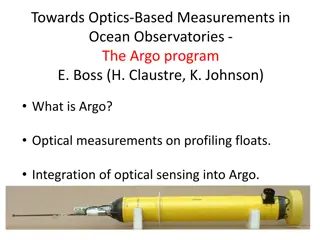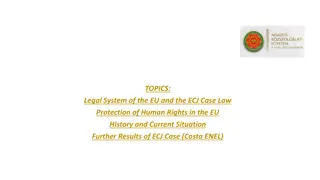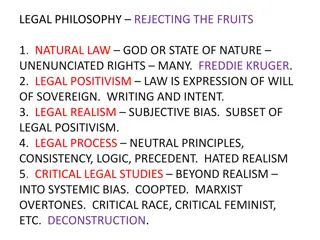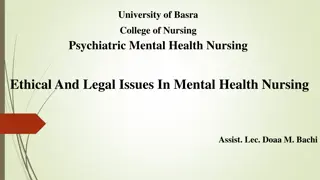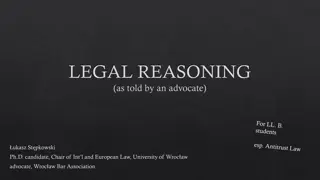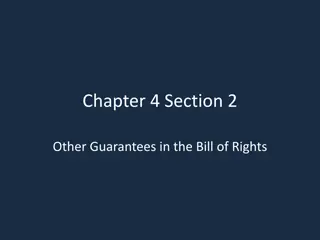Profiling, Travel Bans, and Legal Rights Overview
Profiling individuals based on their characteristics for making decisions raises legal and ethical concerns, particularly when involving race, ethnicity, or religion. This excerpt highlights a case involving profiling during air travel, leading to wrongful detainment and questioning of individuals without evidence of wrongdoing. It emphasizes the importance of legal standards and the defense of qualified immunity in such cases.
Uploaded on Sep 28, 2024 | 0 Views
Download Presentation

Please find below an Image/Link to download the presentation.
The content on the website is provided AS IS for your information and personal use only. It may not be sold, licensed, or shared on other websites without obtaining consent from the author. Download presentation by click this link. If you encounter any issues during the download, it is possible that the publisher has removed the file from their server.
E N D
Presentation Transcript
Chapter 26 PROFILING AND TRAVEL BANS 1
Profiling This is using general characteristics of a class of persons as a basis for making individualized decisions. Profiling is controversial and potentially unconstitutional when the characteristics include race, ethnicity, religion, and other suspect categories. Suspect characteristics can only be used in specific circumstances. The legality of profiling also depends on the legal standards for the use. Border searches require no special suspicion, thus there is no need to give reasons. Arrests require a high standard of knowledge, which profiling generally cannot meet. Non-border immigration stops are between these. 2
Profiling for Arrests Farag v. United States, 587 F. Supp. 2d 436 (EDNY 2008) 3
What happened to plaintiffs? They claim that when they deplaned they were met by at least ten armed police officers in SWAT gear with shotguns and police dogs, ordered to raise their hands, frisked, handcuffed and taken to a police station, where they were placed in jail cells; they were not released until about four hours later, after having been interrogated at length during their imprisonment regarding suspected terrorist surveillance activity aboard the plane. The investigation yielded absolutely no evidence of wrongdoing. 4
What was their ethnicity and citizenship? Both were born in Egypt, but Farag, 36, had moved to the United States in 1971 at age five and later became an American citizen. He was a retired New York City police officer, and was then employed by the United States Bureau of Prisons as a corrections officer. Elmasry, 37, was an Egyptian citizen; he was employed in Egypt by General Electric as an area sales manager for its Africa-East Mediterranean region and had a valid U.S. visa. 5
How did the court describe Farag? As an Arab Why is this troubling? He had grown up in the US and was a citizen 6
What kind action did they bring? Bivens What do defendants claim as their defense? Qualified immunity Was it reasonable for them assume their actions were legal, even if they were not? What suspicious conduct did the government point to? 7
What suspicious things did defendants do when confront by the armed officers? Farag told Smith that after 9/11, when the CIA had c[o]me into the Federal Bureau of Prisons, my supervisors had asked me to translate documents, to translate tapes, [and] in fact I did translate tapes ; Farag told Smith that I had guns pointed at me as a police officer ; While Farag was telling these things to Smith, Farag was jittery and shaking and [his] speech was not calm. He appeared nervous and seemed jumpy and agitated, and he raised his voice. 8
What is the legal test for probable cause to arrest? where the arresting officer has knowledge or reasonably trustworthy information of facts and circumstances that are sufficient to warrant a person of reasonable caution in the belief that the person to be arrested has committed or is committing a crime. Is this an objective or subjective standard, i.e., does the court access the officer s state of mind? Objective Why does the court think the plaintiffs' actions were seen to be suspicious? race 9
What part of the defendants evidence did the court find most troubling? Most troubling, the heavy reliance which the Government places on the plaintiffs speaking loudly to each other over the heads of other passengers and otherwise drawing attention to themselves is counterintuitive: it simply makes no sense that if Elmasry were a terrorist on a surveillance mission, he would speak loudly across the aisle to his companion before takeoff, seek out and converse with the flight attendant, relocate to a seat between two large men, or volunteer to one of those large men that he was from Egypt. 10
Was being nervous in the circumstances suspicious? Reliance on Farag s nervousness and raised voice is also problematic. See, e.g., United States v. Ten Thousand Seven Hundred Dollars and No Cents in U.S. Currency, 258 F.3d 215, 226-27 (3d Cir. 2001) ( [C]laimants apparent nervousness is of minimal probative value, given that many, if not most, individuals can become nervous or agitated when detained by police officers. (citation omitted)). Moreover, Farag s nervous response to an unlawful show of force could not retroactively justify plaintiffs arrests. 11
Can ethnicity serve as a probable cause factor? Does the 4th Amendment ban racial profiling? no What does? Equal protection clause 12
What did the court uphold in Rajah v. Mukasey? This was a government program that singled out male immigrants from two dozen predominantly Arab and Muslim countries for accelerated deportation after the Sept. 11, 2001, terrorist attacks They claimed that they had been impermissibly selected on the basis of their national origin. The Court dismissed their claims, finding: The Executive should not have to disclose its real reasons for deeming nationals of a particular country a special threat or indeed for simply wishing to antagonize a particular foreign country by focusing on that country s nationals and even if it did disclose them a court would be ill equipped to determine their authenticity and utterly unable to assess their adequacy But this was an immigration case, not a criminal arrest. 13
What is the general rule for analyzing a factor used in the probable cause analysis? Although the Fourth Amendment does not single out Although the Fourth Amendment does not single out race as a matter of special concern, it does impose a race as a matter of special concern, it does impose a general requirement that general requirement that any factor considered in a any factor considered in a decision to detain must contribute to a particularized decision to detain must contribute to a particularized and objective basis for suspecting the particular person and objective basis for suspecting the particular person stopped of criminal activity. stopped of criminal activity. 14
When is race clearly allowed? Perhaps the least controversial use of race in the context of the Fourth Amendment is its use as an identifying factor. What about being black in the wrong neighborhood? Driving while black? What else will be necessary in these cases? [T]he officer made clear . . . that while racial incongruity did factor in, he considered other circumstances more important in his decision to make an investigatory stop. ). What about looking Mexican near the border? OK (but this is the border search exception) 15
What about Statistical Correlations between Race and Crime? Reasonable suspicion requires particularized suspicion, and in an area in which a large number of people share a specific characteristic, that characteristic casts too wide a net to play any part in a particularized reasonable suspicion determination. What if the assumption is buried in an algorithm? This is a major issue as police departments use proprietary computer programs to focus resources and courts use them to make bail and sentencing decisions. You cannot cross examine the program for bias. Weapons of Math Destruction excellent, accessible book on algorithmic bias. 16
Did the court accept the special sensitivity caused by 9/11? This justifiable apprehension must be assuaged by This justifiable apprehension must be assuaged by ensuring that security is strictly enforced, and by the ensuring that security is strictly enforced, and by the passage of time without, hopefully, other episodic passage of time without, hopefully, other episodic affronts to our country; affronts to our country; but fear cannot be a factor to but fear cannot be a factor to allow for the evisceration of the bedrock principle of allow for the evisceration of the bedrock principle of our Constitution that no one can be arrested without our Constitution that no one can be arrested without probable cause that a crime has been committed... probable cause that a crime has been committed... 17
Did the court grant summary judgment on the qualified immunity claim? The Court The Court denies summary judgment denies summary judgment with respect to plaintiffs plaintiffs Bivens Bivens claims against Smith and Plunkett, claims against Smith and Plunkett, plaintiffs FTCA claims against the United States, and plaintiffs FTCA claims against the United States, and Smith and Plunkett s qualified immunity defense. Smith and Plunkett s qualified immunity defense. with respect to 18
DOJ Guidance for activities DOJ Guidance for activities other than [Prevention, not punishment] [Prevention, not punishment] In conducting all activities other than routine or spontaneous law In conducting all activities other than routine or spontaneous law enforcement activities, Federal law enforcement enforcement activities, Federal law enforcement officers may consider race, ethnicity, gender, national origin, religion, sexual orientation, or gender ethnicity, gender, national origin, religion, sexual orientation, or gender identity only to the extent that there is trustworthy information, relevant to identity only to the extent that there is trustworthy information, relevant to the locality or time frame, that links persons possessing a particular listed the locality or time frame, that links persons possessing a particular listed characteristic to an identified criminal incident characteristic to an identified criminal incident, scheme, or organization, a threat to national or homeland security, a violation of Federal immigration threat to national or homeland security, a violation of Federal immigration law, or an authorized intelligence activity. law, or an authorized intelligence activity. In order to rely on a listed characteristic In order to rely on a listed characteristic, law enforcement officers must also reasonably believe that the law enforcement, security, or intelligence activity reasonably believe that the law enforcement, security, or intelligence activity to be undertaken is merited under the totality of the circumstances, such as to be undertaken is merited under the totality of the circumstances, such as any temporal exigency and the nature of any potential harm to be averted. any temporal exigency and the nature of any potential harm to be averted. This standard applies even where the use of a listed characteristic might This standard applies even where the use of a listed characteristic might otherwise be lawful. [DOJ Guidance, supra, at 4.] otherwise be lawful. [DOJ Guidance, supra, at 4.] other than routine law enforcement routine law enforcement officers may consider race, , scheme, or organization, a , law enforcement officers must also 19
Examples of Allowable Conduct Example: A terrorist organization that is made up of members of a particular ethnicity sets off a bomb in a foreign country. There is no specific information that the organization is currently a threat to the United States. To gain intelligence on the evolving threat posed by the organization, and to gain insight into its intentions regarding the U.S. homeland and U.S. interests, the FBI may properly consider ethnicity when developing sources with information that could assist the FBI in mitigating any potential threat from the organization. : : : Example. The FBI receives reliable information that persons affiliated with a foreign ethnic insurgent group intend to use suicide bombers to assassinate that country s president and his entire entourage during an official visit to the United States. Agents may appropriately focus investigative attention on identifying members of that ethnic insurgent group who may be present and active in the United States and who, based on other available information, might be involved in planning some such attack during the state visit. 20
Profiling at the border [T]he Department of Homeland Security resisted [T]he Department of Homeland Security resisted efforts to limit the factors it can consider when efforts to limit the factors it can consider when looking for illegal immigrants. looking for illegal immigrants. Department officials argued that it was impractical to ignore ethnicity argued that it was impractical to ignore ethnicity when it came to border enforcement. when it came to border enforcement. The immigration investigators have said The immigration investigators have said, We can t do our job without taking ethnicity into account. We do our job without taking ethnicity into account. We are very dependent on that, are very dependent on that, said one official briefed on the new rules. They want to have the least on the new rules. They want to have the least amount of restrictions holding them back. amount of restrictions holding them back. Department officials , We can t said one official briefed 21
Problems of Applying Racial and Ethnic Classifications in Screening. What if the description is Middle Eastern male, What if the description is Middle Eastern male, Arab ethnicity, or Muslim male ? Arab ethnicity, or Muslim male ? How is this going to work as the basis for random How is this going to work as the basis for random screening on the NYC subway? screening on the NYC subway? Can law enforcement officers even recognize Can law enforcement officers even recognize ethic groups based on their looks? ethic groups based on their looks? The danger of the blond, blue The danger of the blond, blue- -eyed terrorist. eyed terrorist. 22
The Role of Hunches in Screening To insist that an experienced bomb To insist that an experienced bomb- -dog handler or baggage screener ignore any hunches while mindlessly sticking to screener ignore any hunches while mindlessly sticking to random passenger screening is, at best, a waste of limited random passenger screening is, at best, a waste of limited resources. resources. Sky marshals, Transportation Security Sky marshals, Transportation Security Administration screeners, and others on the front lines of Administration screeners, and others on the front lines of counterterrorism should be afforded sufficient discretion to counterterrorism should be afforded sufficient discretion to draw upon their common sense and experience regarding draw upon their common sense and experience regarding people who exhibit nonbehavioral risk factors. people who exhibit nonbehavioral risk factors. What does this look like from the point of view of the folks What does this look like from the point of view of the folks being targeted? being targeted? dog handler or baggage 23
Evaluating Hunches What are the research problems with showing that What are the research problems with showing that profiling for terrorism works? profiling for terrorism works? How do you test the alternative? How do you test the alternative? What is the What is the Matthews Matthews analysis? analysis? What is the harm to profiled individuals versus the What is the harm to profiled individuals versus the benefit to society? benefit to society? 24
National Origin and Religious Profiling Hassan v. City of New York 25
What was the Program? Following the 9/11 attacks, the New York Police Department launched a surveillance program allegedly directed at Muslims and Muslim communities in and around New York City. It involved taking pictures and making video recordings of Muslims and mosques, collecting license plate numbers of congregants at area mosques, using undercover officers (sometimes called mosque crawlers or rakers ) in mosques, organizations, businesses, and neighborhoods believed to be heavily Muslim, and other surveillance techniques. The program generated a series of intelligence reports focusing on the Muslim community in Newark, mapping the location of mosques and Muslim businesses, identifying them as locations of concern, compiling pictures and license plate numbers of mosque congregants, and listing names of persons affiliated with Muslim student organizations. Authorities eventually publicized and defended parts of the program. 26
What are the problems with this program? What is the 1 What is the 1st st amendment problem? amendment problem? What was the empirical problem, i.e., was this finding What was the empirical problem, i.e., was this finding terrorists or criminals? terrorists or criminals? Finally, because Plaintiffs allege that all of these persons Finally, because Plaintiffs allege that all of these persons and entities were surveilled without any reasonable and entities were surveilled without any reasonable suspicion of wrongdoing (as noted above, they assert that, suspicion of wrongdoing (as noted above, they assert that, [i]n all its years of operation, the Program has never [i]n all its years of operation, the Program has never generated a single [criminal] lead, generated a single [criminal] lead, id. {2), easily contrasted with others where the law easily contrasted with others where the law- -enforcement investigation at issue was almost certainly explained by a investigation at issue was almost certainly explained by a reasonable suspicion of wrongdoing. reasonable suspicion of wrongdoing. id. {2), this case can be this case can be enforcement 27
Trump v. Hawaii, 138 S. Ct. 2392 (2018) This is the 3rd revision of the travel ban, with earlier versions having had judicial review problems because they were clearly Muslin bans. This was then revised to include non-Muslin countries and non-religious criteria. The final version, without the rhetoric and history, would not have been very controversial. 28
The Purpose of the Ban The Proclamation (as its title indicates) sought to improve vetting procedures by identifying ongoing deficiencies in the information needed to assess whether nationals of particular countries present public safety threats. 1(a). To further that purpose, the Proclamation placed entry restrictions on the nationals of eight foreign states whose systems for managing and sharing information about their nationals the President deemed inadequate. [No effective way to screen travelers from these countries] 29
Is This a Complete Ban? The Proclamation exempts lawful permanent residents and foreign nationals who have been granted asylum. 3(b). It also provides for case-by-case waivers when a foreign national demonstrates undue hardship, and that his entry is in the national interest and would not pose a threat to public safety. 3(c)(i); see also 3(c)(iv) (listing examples of when a waiver might be appropriate, such as if the foreign national seeks to reside with a close family member, obtain urgent medical care, or pursue significant business obligations). [This is key not including US persons] 30
Who Holds the Power over Immigration? Congress is given plenary authority over immigration. Through time, Congress has used racial and ethnic (and, through racial and ethnic markers, religious) criteria for entry to the US. Since the Constitution does not apply to non-US persons outside the US, this has not raised Constitutional questions. The Court cared less about discrimination in the past when these statutes applied. Wonder what the Court would do today if the issue were squarely presented to the Court? Congress has delegated much of its power to the President by statute, without significant direction. [Same issue with the Emergencies Act and other national security statutes] 31
The Delegation By its terms, 1182(f) exudes deference to the President in every clause. It entrusts to the President the decisions whether and when to suspend entry ( [w]henever [he] finds that the entry of aliens would be detrimental to the national interest); whose entry to suspend ( all aliens or any class of aliens ); for how long ( for such period as he shall deem necessary ); and on what conditions ( any restrictions he may deem to be appropriate ). It is therefore unsurprising that we have previously observed that 1182(f) vests the President with ample power to impose entry restrictions in addition to those elsewhere enumerated in the INA. 32
What is the Statutory Test? The sole prerequisite set forth in 1182(f) is that the President find[ ] that the entry of the covered aliens would be detrimental to the interests of the United States. [As with the National Emergencies Act, there is no definition of what the finding needs to include or limitations on it.] 33
Does the Proclamation Meet the Test? The President then issued a Proclamation setting forth extensive findings describing how deficiencies in the practices of select foreign governments several of which are state sponsors of terrorism deprive the Government of sufficient information to assess the risks [those countries nationals] pose to the United States. Based on that review, the President found that it was in the national interest to restrict entry of aliens who could not be vetted with adequate information both to protect national security and public safety, and to induce improvement by their home countries. The Proclamation therefore craft[ed] : : : country-specific restrictions that would be most likely to encourage cooperation given each country s distinct circumstances, while securing the Nation until such time as improvements occur. 34
The Plaintiffs Record Challenge Plaintiffs challenge the adequacy of the record to support the findings. This was a good challenge to the first version, but the record has been fixed in the version before the Court. 35
Claimed Conflict with the Statute Plaintiffs structural argument starts with the premise that 1182(f) does not give the President authority to countermand Congress s considered policy judgments. First, Congress designed an individualized vetting system that places the burden on the alien to prove his 802 admissibility. Second, instead of banning the entry of nationals from particular countries, Congress sought to encourage information sharing through a Visa Waiver Program offering fast-track admission for countries that cooperate with the United States. These both depend on adequate information and a working consular system. The ban does preserve some case-by-case inquiry. 36
The Anti-Discrimination Clause in the Act Plaintiffs final statutory argument is that the President s entry suspension violates 1152(a)(1)(A) which provides that no person shall . . . be discriminated against in the issuance of an immigrant visa because of the person s race, sex, nationality, place of birth, or place of residence. W]e reject plaintiffs interpretation because it ignores the basic distinction between admissibility determinations and visa issuance that runs throughout the INA. Section 1182 defines the pool of individuals who are admissible to the United States. [There are no constitutional rights in group admission decisions foreign nationals on foreign soil.] 37
Group Admissibility v. Individual Visas Sections 1182(f) and 1152(a)(1)(A) thus operate in different spheres: Section 1182 defines the universe of aliens who are admissible into the United States (and therefore eligible to receive a visa). Once 1182 sets the boundaries of admissibility into the United States, 1152(a)(1)(A) prohibits discrimination in the allocation of immigrant visas based on nationality and other traits. The distinction between admissibility to which 1152(a)(1)(A) does not apply and visa issuance to which it does is apparent from the text of the provision, which specifies only that its protections apply to the issuance of immigrant visa[s], without mentioning admissibility or entry. 38
Extra-Record Evidence of a Religious Gerrymander At the heart of plaintiffs case is a series of statements by the President and his advisers casting doubt on the official objective of the Proclamation. For example, while a candidate on the campaign trail, the President published a Statement on Preventing Muslim Immigration that called for a total and complete shutdown of Muslims entering the United States until our country s representatives can figure out what is going on. That statement remained on his campaign website until May 2017. Then-candidate Trump also stated that Islam hates us and asserted that the United States was having problems with Muslims coming into the country. Shortly after being elected, when asked whether violence in Europe had affected his plans to ban Muslim immigration, the President replied, You know my plans. All along, I ve been proven to be right. 39
Should the Court Go Behind the Record? What should be considered, once you go outside the record? Could this be a problem for climate change regulations? The War on Coal rhetoric The general hatred of oil companies by environmental groups. Going behind the record in a national security case which normally has limited review is troubling for administrative law cases, which are already subject to hard look review. 40
The Standard of Review in National Security Cases The upshot of our cases in this context is clear: Any rule of constitutional law that would inhibit the flexibility of the President to respond to changing world conditions should be adopted only with the greatest caution, and our inquiry into matters of entry and national security is highly constrained. Mathews, 426 U.S., at 81-82. We need not define the precise contours of that inquiry in this case. A conventional application of Mandel, asking only whether the policy is facially legitimate and bona fide, would put an end to our review. [The Court could have stopped here in administrative law terms, the record fully justifies the ruling.] 41
The Korematsu Problem Finally, the dissent invokes Korematsu v. United States, 323 U.S. 214 (1944). Whatever rhetorical advantage the dissent may see in doing so, Korematsu has nothing to do with this case. The forcible relocation of U.S. citizens to concentration camps, solely and explicitly on the basis of race, is objectively unlawful and outside the scope of Presidential authority. But it is wholly inapt to liken that morally repugnant order to a facially neutral policy denying certain foreign nationals the privilege of admission. The entry suspension is an act that is well within executive authority and could have been taken by any other President the only question is evaluating the actions of this particular President in promulgating an otherwise valid Proclamation. Trump exceptionalism 42
Is the Court Overruling Korematsu? The dissent s reference to Korematsu, however, affords this Court the opportunity to make express what is already obvious: Korematsu was gravely wrong the day it was decided, has been overruled in the court of history, and to be clear has no place in law under the Constitution. 323 U.S., at 248 (Jackson, J., dissenting). 43
Note 8. Religious Profiling at the border Tabbaa v. Chertoff, 509 F.3d 89 (2d Cir. 2007) 44
What triggered the stop? CBP had received classified information giving it reason to believe that terrorists or persons with terrorist ties would be attending a Muslim religious conference in Canada, which drew 13,000 individuals from across North America. 45
What did the Border Agents Do? Without any particularized suspicion, CBP agents then stopped a group of Muslim U.S. citizens at the border on their return from the conference and frisked, fingerprinted, photographed, questioned, and detained them for four to six hours, without telling them why they had been pulled aside. 46
What happened at court? When these citizens challenged these actions in court, the court of appeals ultimately ruled that, as routine border searches, the actions did not violate the Fourth Amendment. It also held that the actions did not violate the plaintiffs First Amendment rights of association or religious freedom under a strict scrutiny test, because they served a compelling counterterrorism need, and, at the border, this need could not have been satisfied by any significantly less restrictive means. 47
Tanvir v. Tanzin, 894 F.3d 449 (2d Cir. 2018), affirmed by Tanzin v. Tanvir, 141 S. Ct. 486, 208 L. Ed. 2d 295 (2020) Tanvir and his fellow Muslim plaintiffs had become either citizens or permanent resident aliens after immigrating to the United States. They had family in Pakistan (and possibly Afghanistan) whom they desired to visit from time to time. Alleging that the FBI threatened to and did place them on the No Fly list unless they agreed to spy and inform on their Muslim communities abroad, they brought claims for damages under the First Amendment and the Religious Freedom Restoration Act (RFRA). 48
The Court Ruling The court of appeals held that RFRA permits a plaintiff to recover money damages against federal officers sued in their individual capacities for violations of RFRA s substantive protections. Affirmed, 8-0, in an opinion by Justice Thomas on December 10, 2020. Justice Barrett took no part in the consideration or decision of this case. There is no further history, so the case was likely settled. This case creates a new path to challenge these actions. Remember, this is not a border entry case but a US person in the US case. 49








